当前位置:网站首页>Shangsilicon Valley JUC high concurrency programming learning notes (3) multi thread lock
Shangsilicon Valley JUC high concurrency programming learning notes (3) multi thread lock
2022-07-06 18:18:00 【exodus3】
One 、 Multithreaded locks
At some point , Only one thread can access these synchronized Method .
All static synchronization methods use the same lock —— Class object itself , These two locks are two different objects , So there is no race condition between static synchronization method and non static synchronization method . But once a static synchronization method gets the lock , Other static synchronization methods must wait for the method to release the lock before it can acquire the lock , Whether it's between static synchronization methods of the same instance object , Or between static synchronization methods of different instance objects , As long as they are instance objects of the same class .
synchronized The method of locking is , Object lock
The mechanism of locking the same object needs to wait , Different object lock mechanisms call the same one without waiting
added static Then for class Locks, not object locks

Analyze through specific examples
Two thread safe methods, a common method
class Phone {
public synchronized void sendSMS() throws Exception {
// Stop 4 second
TimeUnit.SECONDS.sleep(4);
System.out.println("------sendSMS");
}
public synchronized void sendEmail() throws Exception {
System.out.println("------sendEmail");
}
public void getHello() {
System.out.println("------getHello");
}
}
public class Lock_8 {
public static void main(String[] args) throws Exception {
Phone phone = new Phone();
Phone phone2 = new Phone();
new Thread(() -> {
try {
phone.sendSMS();
} catch (Exception e) {
e.printStackTrace();
}
}, "AA").start();
Thread.sleep(100);
new Thread(() -> {
try {
// phone.sendEmail();
// phone.getHello();
phone2.sendEmail();
} catch (Exception e) {
e.printStackTrace();
}
}, "BB").start();
}
}
The specific eight cases are
1 Standard access , Print SMS or email first
------sendSMS
------sendEmail
2 stop 4 Seconds in the SMS method , Print SMS or email first
------sendSMS
------sendEmail
3 Add common hello Method , Whether to text first or hello
------getHello
------sendSMS
4 Now there are two mobile phones , Print SMS or email first
------sendEmail
------sendSMS
5 Two static synchronization methods ,1 Mobile phone , Print SMS or email first
------sendSMS
------sendEmail
6 Two static synchronization methods ,2 Mobile phone , Print SMS or email first
------sendSMS
------sendEmail
7 1 Static synchronization methods ,1 A common synchronization method ,1 Mobile phone , Print SMS or email first
------sendEmail
------sendSMS
8 1 Static synchronization methods ,1 A common synchronization method ,2 Mobile phone , Print SMS or email first
------sendEmail
------sendSMS
summary :
1.- The same object accesses different synchronization locks , Is executed in order
The same object accesses synchronous and asynchronous locks , First, lock the execution asynchronously
Different objects access different synchronization locks , Execute in order
2.- The same object accesses different static synchronization locks , Execute in order
Different objects access different static synchronization locks , Execute in order
3.- The same object accesses a static synchronization lock , A synchronous lock , First execute the synchronization lock
Different objects access a static synchronization lock , A synchronous lock , First execute the synchronization lock
That is, first out synchronization lock before out static synchronization lock
Two 、 Fair and non-fair locks
Fair lock : Relatively inefficient
Not fair lock : Efficient , But threads starve easily
By looking at the source code , With parameters ReentrantLock(true) Lock for fairness ,ReentrantLock(false) Lock for unfairness
Mainly called NonfairSync() And FairSync()
public ReentrantLock() {
sync = new NonfairSync();
}
/** * Creates an instance of {@code ReentrantLock} with the * given fairness policy. * * @param fair {@code true} if this lock should use a fair ordering policy */
public ReentrantLock(boolean fair) {
sync = fair ? new FairSync() : new NonfairSync();
}
Specifically, the source code of its unfair lock and fair lock
View the source code of fair lock
static final class FairSync extends Sync {
private static final long serialVersionUID = -3000897897090466540L;
/** * Acquires only if reentrant or queue is empty. */
final boolean initialTryLock() {
Thread current = Thread.currentThread();
int c = getState();
if (c == 0) {
if (!hasQueuedThreads() && compareAndSetState(0, 1)) {
setExclusiveOwnerThread(current);
return true;
}
} else if (getExclusiveOwnerThread() == current) {
if (++c < 0) // overflow
throw new Error("Maximum lock count exceeded");
setState(c);
return true;
}
return false;
}
Specific operations through code examples
In the front ticketing code , Continue to refer to the previous code
// First step Create a resource class , Define properties and operation methods
class LTicket {
// Number of tickets
private int number = 30;
// Create a reentrant lock
private final ReentrantLock lock = new ReentrantLock();
// Ticket selling method
public void sale() {
// locked
lock.lock();
try {
// Judge whether there is a ticket
if(number > 0) {
System.out.println(Thread.currentThread().getName()+" : sell "+(number--)+" The remaining :"+number);
}
} finally {
// Unlock
lock.unlock();
}
}
}
public class LSaleTicket {
// The second step Create multiple threads , Call the operation method of the resource class
// Create three threads
public static void main(String[] args) {
LTicket ticket = new LTicket();
new Thread(()-> {
for (int i = 0; i < 40; i++) {
ticket.sale();
}
},"AA").start();
new Thread(()-> {
for (int i = 0; i < 40; i++) {
ticket.sale();
}
},"BB").start();
new Thread(()-> {
for (int i = 0; i < 40; i++) {
ticket.sale();
}
},"CC").start();
}
}
Output results
AA : sell 30 The remaining :29
AA : sell 29 The remaining :28
AA : sell 28 The remaining :27
AA : sell 27 The remaining :26
AA : sell 26 The remaining :25
AA : sell 25 The remaining :24
AA : sell 24 The remaining :23
AA : sell 23 The remaining :22
AA : sell 22 The remaining :21
AA : sell 21 The remaining :20
AA : sell 20 The remaining :19
AA : sell 19 The remaining :18
AA : sell 18 The remaining :17
AA : sell 17 The remaining :16
AA : sell 16 The remaining :15
AA : sell 15 The remaining :14
AA : sell 14 The remaining :13
AA : sell 13 The remaining :12
AA : sell 12 The remaining :11
AA : sell 11 The remaining :10
AA : sell 10 The remaining :9
AA : sell 9 The remaining :8
AA : sell 8 The remaining :7
AA : sell 7 The remaining :6
AA : sell 6 The remaining :5
AA : sell 5 The remaining :4
AA : sell 4 The remaining :3
AA : sell 3 The remaining :2
AA : sell 2 The remaining :1
AA : sell 1 The remaining :0
Process finished with exit code 0
All are A Threads execute , and BC The thread didn't execute ( Or the probability of a thread appearing is very high , The probability of other threads is very small ), There is an unfair lock .
The setting can be changed through a parametric construction method in the reentrant lock
Change the code to private final ReentrantLock lock = new ReentrantLock(true);
This is the Fair lock , Every thread has a chance to appear .
give the result as follows :
AA : sell 30 The remaining :29
AA : sell 29 The remaining :28
AA : sell 28 The remaining :27
AA : sell 27 The remaining :26
AA : sell 26 The remaining :25
AA : sell 25 The remaining :24
AA : sell 24 The remaining :23
AA : sell 23 The remaining :22
AA : sell 22 The remaining :21
AA : sell 21 The remaining :20
AA : sell 20 The remaining :19
AA : sell 19 The remaining :18
AA : sell 18 The remaining :17
AA : sell 17 The remaining :16
BB : sell 16 The remaining :15
AA : sell 15 The remaining :14
CC : sell 14 The remaining :13
BB : sell 13 The remaining :12
AA : sell 12 The remaining :11
CC : sell 11 The remaining :10
BB : sell 10 The remaining :9
AA : sell 9 The remaining :8
CC : sell 8 The remaining :7
BB : sell 7 The remaining :6
AA : sell 6 The remaining :5
CC : sell 5 The remaining :4
BB : sell 4 The remaining :3
AA : sell 3 The remaining :2
CC : sell 2 The remaining :1
BB : sell 1 The remaining :0
Process finished with exit code 0
3、 ... and 、 Reentrant lock
synchronized and lock Are reentrant locks
sychronized It's an implicit lock , No manual locking and unlocking , and lock To display the lock , Manual locking and unlocking are required .
Reentrant locks are also called recursive locks
And with the reentrant lock , After cracking the first one, you can go all the way to the inner structure .
Object o = new Object();
new Thread(()->{
synchronized(o) {
System.out.println(Thread.currentThread().getName()+" Outer layer ");
synchronized (o) {
System.out.println(Thread.currentThread().getName()+" Middle level ");
synchronized (o) {
System.out.println(Thread.currentThread().getName()+" Inner layer ");
}
}
}
},"t1").start();
result
t1 Outer layer
t1 Middle level
t1 Inner layer
Process finished with exit code 0
synchronized (o) Means to lock the current { } Code block inside
All of these are synchronized Locking mechanism
The following interpretation lock Locking mechanism
public class SyncLockDemo {
public synchronized void add() {
add();
}
public static void main(String[] args) {
//Lock Demonstrate reentrant locks
Lock lock = new ReentrantLock();
// Create thread
new Thread(()->{
try {
// locked
lock.lock();
System.out.println(Thread.currentThread().getName()+" Outer layer ");
try {
// locked
lock.lock();
System.out.println(Thread.currentThread().getName()+" Inner layer ");
}finally {
// Release the lock
lock.unlock();
}
}finally {
// Release do
lock.unlock();
}
},"t1").start();
// Create a new thread
new Thread(()->{
lock.lock();
System.out.println("aaaa");
lock.unlock();
},"aa").start();
}
}
result
t1 Outer layer
t1 Inner layer
aaaa
Process finished with exit code 0
Nested locks in the same lock , If the internal nested lock is not unlocked, it can still be output , But if you jump out of the thread , Executing another thread will cause deadlock .
Grasp the concept of locking and unlocking , All have to write .
Four 、 Deadlock
The phenomenon that two or more processes wait for resources because of competing for resources is called deadlock .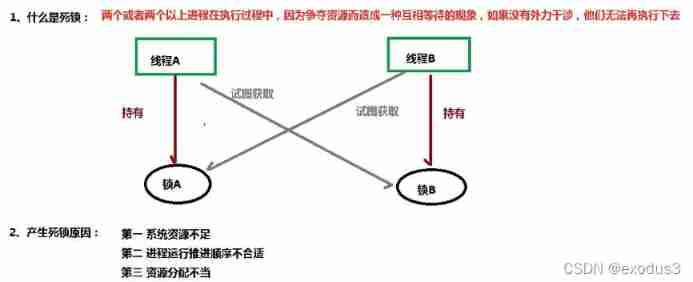
Cause of deadlock :
Insufficient system resources
Improper allocation of system resources
Improper running sequence of processes
Verify whether it is a deadlock
jps Be similar to linux Medium ps -ef View process number
jstack Built in stack trace tool
Deadlock verification process :
1、 Deadlock code :
public class DeadLock {
// Create two objects
static Object a = new Object();
static Object b = new Object();
public static void main(String[] args) {
new Thread(()->{
synchronized (a) {
System.out.println(Thread.currentThread().getName()+" Hold lock a, Trying to get lock b");
try {
TimeUnit.SECONDS.sleep(1);
} catch (InterruptedException e) {
e.printStackTrace();
}
synchronized (b) {
System.out.println(Thread.currentThread().getName()+" Get the lock b");
}
}
},"A").start();
new Thread(()->{
synchronized (b) {
System.out.println(Thread.currentThread().getName()+" Hold lock b, Trying to get lock a");
try {
TimeUnit.SECONDS.sleep(1);
} catch (InterruptedException e) {
e.printStackTrace();
}
synchronized (a) {
System.out.println(Thread.currentThread().getName()+" Get the lock a");
}
}
},"B").start();
}
}
The program didn't stop 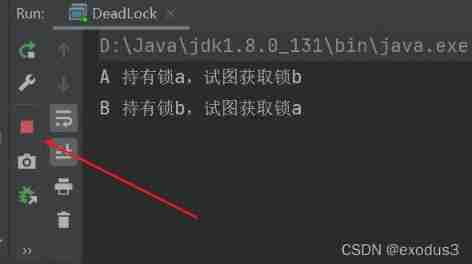
By using idea Self contained command line input jps -l
After checking the process number of its compiled code jstack Process number
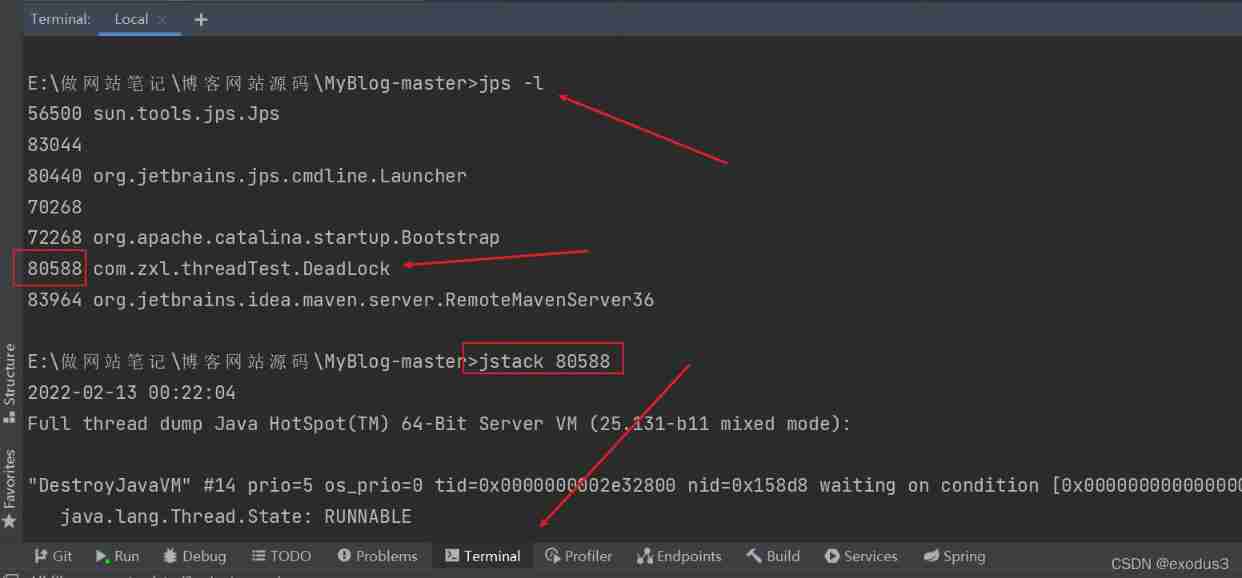
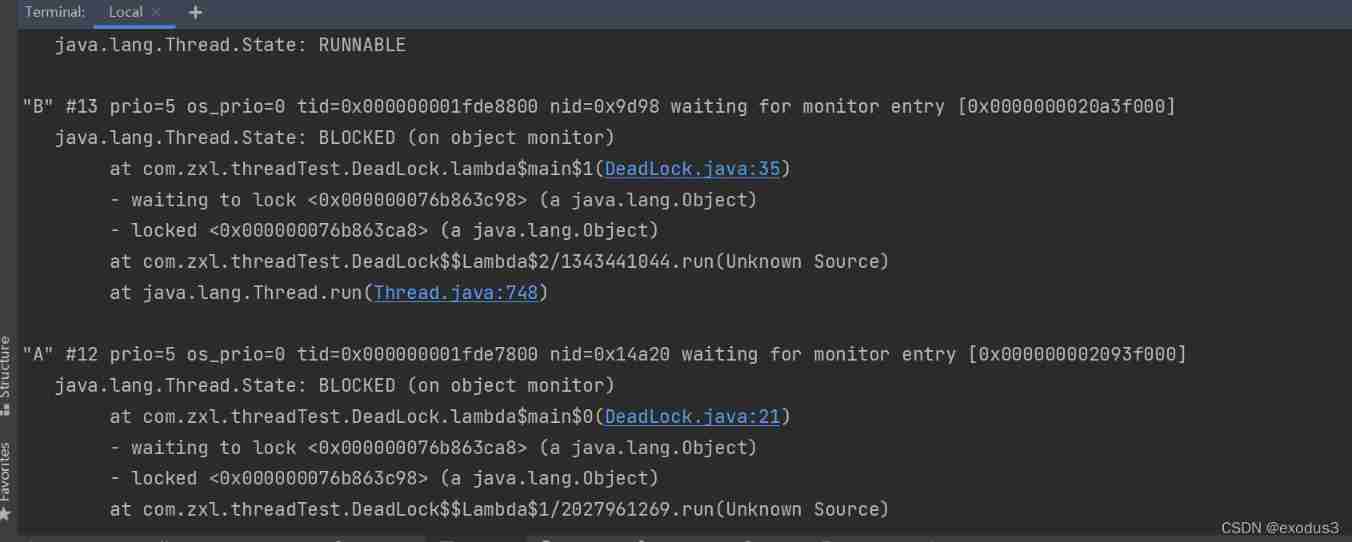
边栏推荐
猜你喜欢

關於這次通信故障,我想多說幾句…

带你穿越古罗马,元宇宙巴士来啦 #Invisible Cities
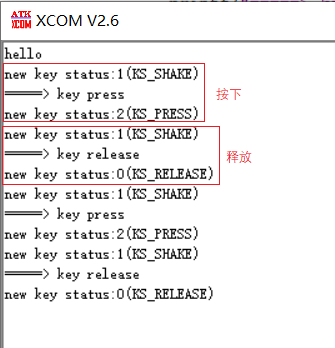
STM32 key state machine 2 - state simplification and long press function addition

简单易用的PDF转SVG程序

declval(指导函数返回值范例)
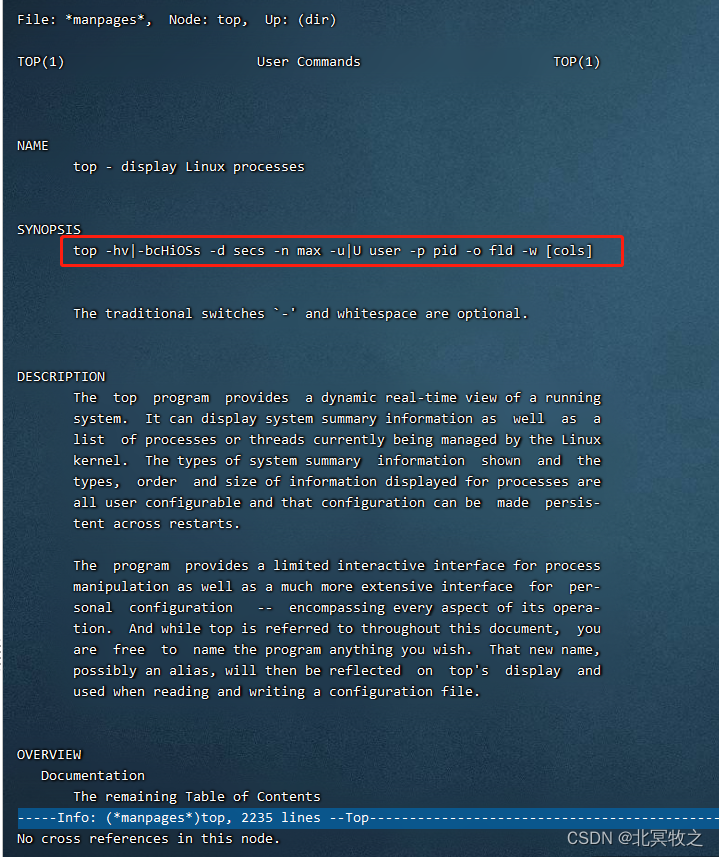
Top command details
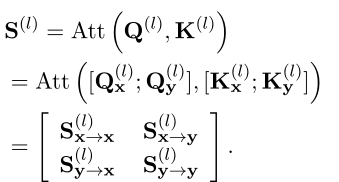
从交互模型中蒸馏知识!中科大&美团提出VIRT,兼具双塔模型的效率和交互模型的性能,在文本匹配上实现性能和效率的平衡!...

從交互模型中蒸餾知識!中科大&美團提出VIRT,兼具雙塔模型的效率和交互模型的性能,在文本匹配上實現性能和效率的平衡!...

虚拟机VirtualBox和Vagrant安装
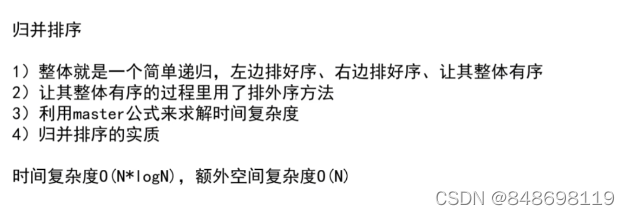
递归的方式
随机推荐
AFNetworking框架_上传文件或图像server
Reprint: defect detection technology of industrial components based on deep learning
Jerry's access to additional information on the dial [article]
Will openeuler last long
[Android] kotlin code writing standardization document
C语言自动预订飞机票问题
Jerry is the custom background specified by the currently used dial enable [chapter]
IP, subnet mask, gateway, default gateway
Transport layer congestion control - slow start and congestion avoidance, fast retransmission, fast recovery
Excellent open source fonts for programmers
atcoder它A Mountaineer
C language college laboratory reservation registration system
STM32按键状态机2——状态简化与增加长按功能
STM32+ESP8266+MQTT协议连接OneNet物联网平台
Jerry's watch reading setting status [chapter]
declval(指导函数返回值范例)
测试1234
Transfer data to event object in wechat applet
DOM简要
78 year old professor Huake has been chasing dreams for 40 years, and the domestic database reaches dreams to sprint for IPO